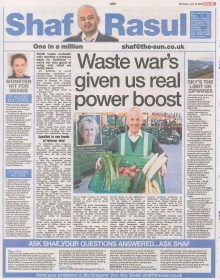Food waste undoubtedly remains a massive issue for Scotland – we’re just not very good at using only what we really need.
It’s difficult to avoid comparing ourselves to similar-sized Scandinavian countries where the streets seem to always be clean, the people lead healthy lifestyles, and sustainable thinking is ingrained.
But we’re getting better at recycling here. In fact, new figures from Zero Waste Scotland indicate that recycling of food waste north of the border has risen by more than 40 per cent in recent years, which is great progress by anyone’s yardstick.
The body, which works with businesses and organisations to enable change in Scotland’s resources use, believes that some 158,500 tonnes of household and commercial solid food waste were collected and processed in 2017, compared with 111,500 in 2013.
That’s meant that more and more food scraps have been successfully recycled and converted into renewable energy.
To illustrate this progress, Zero Waste Scotland offered up a great stat – that the emissions saved represent the equivalent of taking more than 22,000 cars off the road for a year.
Arguably an even better one is that the renewable energy produced from food waste in 2017 was enough to power nearly 20,000 homes.
In other words, it seems we’re collectively taking significant strides towards more sustainable, responsible lifestyles, increasingly avoiding unnecessary landfill that produces damaging methane gas, and reaping the benefits.
Of course, perhaps more importantly, it also indicates that businesses – traditionally among the biggest culprits – are getting on board to ensure greater efficiency in their processes and proactively limiting environmental impacts.
It’s great to see, for instance, the UK’s biggest supermarket Tesco taking a strong stance by working with FareShare to redistribute food to charities and community groups – helping everything from children’s breakfast clubs to homeless shelters.
I don’t know about you, but I think we’re beginning to see the seeds of better, more eco-friendly habits starting to embed themselves.
On a personal level, I’m always appalled to see ridiculous amounts of leftover food going straight in the bin and I try to instil a sense of responsibility in my nearest and dearest to avoid that as much as possible.
That’s just good environmental sense if we want to offset climate change and reduce emissions to net-zero by 2045 – as the Scottish Government is trying to do – not to mention adopting an approach that’s going to make your bank manager a bit cheerier. It’s a win-win.
Welcoming the news, Environment Secretary Roseanna Cunningham rightly stated that it was vital small changes were applied to the Scottish population’s daily routine as they would result in big differences for the future of the planet.
If we apply a number of those changes then the benefits are multiplied – think the likes of electric cars, cities powered by artificial intelligence for smarter use of resources, and a deposit return scheme (DRS) for Scotland to encourage recycling.
Revellers at the Belladrum Tartan Heart Festival taking place near Inverness next month will pay a 10p deposit when they buy plastic bottles with a capacity of up to two litres at Co-op’s pop-up stores. As part of a fully functional trial, they are then able to use reverse vending machines in dedicated ‘recycling rooms’ to return their empty bottles and get their deposit back in the form of a voucher to spend in the on-site stores.
Or they can even choose to donate their 10p to Keep Britain Tidy.
It’s a laudable scheme and one that makes huge sense as we prepare to see a nationwide deposit return scheme rollout in the near future.
Scotland may be playing catch-up with many parts of the world when it comes to better looking after the environment, but we’re fast closing the gap.
Another exciting tourism development: Scotland’s longest zip-wire is coming to Loch Leven.
Developers have revealed multi-million pound plans to install Scotland’s longest zip-wire at Kinlochleven, giving tourists a unique opportunity to experience the beautiful Highlands from the sky.
The £3.5m attraction will feature two wires – the longest stretching an impressive 1,619 yards – plus platforms, jetties, and a reception building. It’s expected to create 50 job opportunities and give the village a fantastic economic boost.
The project leader has pledged to donate a portion of the turnover to the community to support local charities.
This is a fantastic opportunity for the village to become a focal spot for those seeking a thrill in the highlands.
Laugh
The Loch Ness Monster now has its own tartan.
It makes me chuckle that it’s also happened just in time for the summer holidays. The tartan was designed by Mairi Macleod of House of Edgar and is expected to be a hit with tourists.
Visitors travel far and wide to spot Nessie, and businesses continue to benefit. I look forward to seeing fans sporting the tartan – maybe Nessie too!
Weep
It disheartens me that our neighbours in America might not be able to enjoy one of our finest exports.
Whisky is among the products that might receive new tariffs as trade wars continue.
The US is Scotland’s biggest whisky export market, worth £1.04bn last year. Scotch whisky has benefited from a zero-tariff rate for over 20 years.
If tariffs are imposed, it could severely impact Scottish distilleries, though locals might find more whisky circulating here. Let’s hope the trade row doesn’t derail this vital sector.


